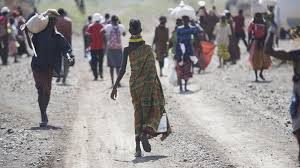But as you look around, your gaze falls on a newspaper on the coffee table. The headline reads “Worldwide crop failures in 2049: How will we eat?” You hear the radio announcer talking about eco-terrorists, the hijacking of supermarket trucks, extreme weather and poor air quality. Flip through a ledger on the dining room table, and you’ll see a record of the family’s experiments in growing food, next to vials of carefully labeled seeds. The jars of preserves on the shelves turn out to be marked with the month, year and place where the food was foraged. Scan the cookbooks on the shelves, and you’ll see titles like How to Cook in Scarcity and, more alarmingly, Pets as Protein. Recipes tacked to the kitchen wall offer ways to prepare mealworms and foxes. An unsettling peek into the reality of life in 2050 SDG 2 Zero Hunger
Envisioning the world some thirty years out through the lens of the Global Goals.
SDG 11 Sustainable Cities and Communities
[title type=”h3″]Sea Level Rise[/title]
Pressure is already growing on cities, as urban populations grow. If climate change forces mass migration, then existing infrastructure, services and economies may be stretched to breaking point 10 Grand Challenges We’ll Face by 2050
…from 25 million to 1 billion “environmental migrants” by 2050. These estimates are wide ranging because the links between climate change and migration are extremely complex and not always direct. It is extremely difficult to isolate climate-specific factors from general environmental challenges that result in migration. For example, climate change can exacerbate natural disasters such as tropical storms, which may also lead to secondary impacts such as landslides. But while sudden natural disasters are likely to result in mass displacement, more people are expected to migrate because of the slow deterioration of their local environment.Climate-Induced Migration: A Looming Crisis
SDG 6 Ensure availability and sustainable management of water and sanitation for all
[title type=”h3″]Food & Water Security[/title]
The widespread use of nano-tech grapheme to desalinate sea water could play a major role in addressing both food and water security, significantly increasing the amount of clean water for farming, drinking, and sanitation. Earth 2050
When the common salts are dissolved in water, they always form a ‘shell’ of water molecules around the salts molecules. This allows the tiny capillaries of the graphene-oxide membranes to block the salt from flowing along with the water. Water molecules are able to pass through the membrane barrier and flow anomalously fast which is ideal for application of these membranes for desalination. Graphene sieve turns seawater into drinking water
SDG 7 Affordable and Clean Energy and SDG 9 Industry, Innovation and Infrastructure
Scientists are also employing nanotechnology, specifically once again graphene, in developing vast amounts of alternative renewable energy:
“Nanotechnology may accelerate the technology behind renewables in various ways:experts are discovering means to apply nanotechnology to photovoltaics, which would produce solar panels with double or triple the output by 2020; wind turbines stand to be improved from high-performance nano-materials like graphene, a nano-engineered one-atom thick layer of mineral graphite that is 100 times stronger than steel. Nanotechnology will enable light and stiff wind blades that spin at lower wind speeds than regular blades;nanotechnology could play a major role in the next generation of batteries. For example, coating the surface of an electrode with nanoparticles increases the surface area, thereby allowing more current to flow between the electrode and the chemicals inside the battery.” Link

